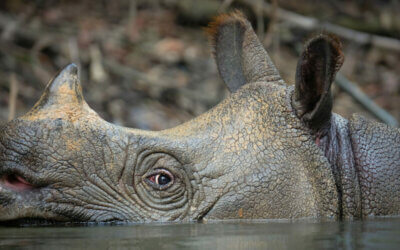Nature-Based Solutions
Intact, functional nature is at the heart of finding solutions to three of the world’s most pressing issues: climate change, biodiversity loss, and sustainable food production
A WILD Foundation Background Paper
- Large-scale transformation of the Earth
Humanity has a profound impact on the Earth. A century ago[1], only 15% of the surface was used to grow crops and raise livestock. Today, human activities have modified more than 77% of land (excluding Antarctica) and 87% of the ocean. As late as between 1993 and 2009, an area of terrestrial wild nature larger than India – a staggering 3.3 million square kilometres – was lost to human settlement, farming, mining and other pressures. In the ocean, areas free of industrial fishing, pollution and shipping are almost completely confined to the Polar Regions. Over a third of planet’s original forest cover has been cleared including half of the tropical forests, much of that in the last sixty years[2]. The wetlands have declined between 64-71% in the 20th century, with 30% in the last 40 years alone[3]. Almost half of the global river volume is altered through dams and diversions[4]. Only 13% of the ocean meets the definition of global wilderness, with most being located in the high seas[5]. Fifty per cent of the historical global coverage of tidal marshes has been lost, and between 1980 and 2000, 35% of the mangroves were lost[6]. Since grasslands normally are very suitable for farming, they are considered the most altered terrestrial ecosystem on the planet, especially in the temperate zone with 46% converted to human use[7]. Habitat conversion exceeds 50% in 202 of the world’s 810 terrestrial ecoregions[8].
- Planet’s sixth mass extinction of life at our doorstep
Current rates of extinction are about 1000 times the likely background rate of extinction[9]. Future rates depend on many factors and are poised to increase. Out of 98,500 species assessed, 27,000 are threatened with extinction (27%)[10]. Most threatened are amphibians (40%) followed by conifers (34%), reef corals (33%), sharks and rays (31%), mammals (25%) and birds (14%). Habitat loss – and especially deforestation – appears to be by far the most pervasive threat, impacting 86% of threatened birds, 86% of threatened mammals and 88% of threatened amphibians[11]. Habitat loss will remain a dominant threat, as there is no sign that human transformation of the landscape is slowing. Threat processes in the marine and freshwater systems are poorly understood. However, it appears that over- exploitation is presently the greatest threat to marine species, followed by habitat loss. Incidental mortality as a result of fisheries is an increasing threat, affecting seabirds, marine mammals, and other marine species. Habitat loss is likely the most severe threat to freshwater species followed by pollution and invasive species.
An overall population decline globally of over 50% in less than 50 years has been documented for 4,000 vertebrate species, with the most dramatic changes in South and Central America and the Caribbean (89%) followed by Indo-Pacific (64%), tropical Africa (56%), Palearctic (31%) and North America (23%)[12]. Most affected are freshwater species with an overall decline of 81% between 1970 and 2012[13]. Tropical forest species declined with 41% between 1970 and 2009, and marine species with 36% between 1970 and 2012, however, with a slight stabilisation after 1988 of several fish species with populations either fully fished or overfished[14].
An analysis of insect populations in the northern hemisphere, concludes that about one third of all species are threatened with extinction, with an additional one per cent of species added every year, which corresponds to an annual loss of biomass of 2.5%[15]. Most affected groups are butterflies and moths (53%), beetles (49%) and bees (46%) – many of which play a crucial role for pollination. The main, negative factor has been habitat loss and conversion to intensive agriculture followed by pollution due to pesticides and fertilisers. In tropical forests the increase of temperatures due to climate change has led to dramatic decline of arthropods, especially insects, which in turn has restructured the entire rainforest food webs with subsequent declines of lizards, frogs and birds living on insects[16]. With forecasted rapid increases of temperatures, the negative impacts are expected to be even more dramatic. The insect trends confirm that the sixth major extinction event is profoundly impacting many life forms of our planet.
- Destruction and degradation of nature is a major driver of the climate change crisis
Nature plays a crucial role in absorbing and storing carbon, and thus helping us from climate change. Currently, land and sea absorb roughly half of the CO2 emissions humanity generates[17]. Ecosystems on land store almost three times as much as is currently present in the atmosphere. Oceans and coastal areas are critical in managing carbon, where around 83% of the global cycle is circulated through the ocean, with the deep seas storing the largest amounts. Therefore the maintenance of existing natural carbon reservoirs worldwide is essential if carbon capture and storage is to make a major contribution to climate mitigation. After emissions from fossil fuel burning, land-use change currently contributes with the second largest CO2 emissions[18].
Primary forests, especially with big trees, contain massive carbon stocks and also act as a major carbon sink[19]. This applies to tropical, temperate and boreal forests, which together harbor 45% of the terrestrial carbon stock. Deforestation alone releases approximately 20% of the global CO2 emissions. Wetlands store twice as much carbon as forests but they are also the largest natural source of methane, a very potent greenhouse gas, especially when not well managed[20]. Higher temperatures under climate change are expected to increase greenhouse emissions from wetlands, particularly where warming leads to permafrost melting generating large amounts of CO2 and methane. Coastal habitats such as salt marshes, mangroves and seagrass beds are efficient “blue” carbon sinks[21], but with their present rates of destruction of 1-2% per year they release CO2, like the disappearance of mangroves, which is estimated to contribute with 10% of the emissions from deforestation globally despite covering just 0.7% of the land. Natural grasslands store approximately 25% of the global carbon stock[22]. Unlike tropical forests, where vegetation is the primary source of carbon storage, most of the grassland carbon stocks are in the soil. Cultivation and urbanization of grasslands, and other modifications of grasslands through desertification and livestock grazing can be a significant source of carbon emissions.
- Climate change is changing the entire web of life
Although habitat loss currently is the most cited threat to species, climate change is arguably the greatest emerging threat to global biodiversity and the functioning of ecosystems[23]. With only a ~1oC of warming globally, more than 80% of ecological processes that form the foundation for healthy marine, freshwater and terrestrial ecosystems – such as changes to genetic diversity or seasonal migration – are already showing signs of distress and altering as a response to climate change. Approximately 20-30% plant and animal species assessed so far are likely to be at increased risk of extinction if increases in global average temperatures exceed 1.5-2.5oC. This warming is projected to introduce major changes in ecosystem structure and function, species’ ecological interactions and geographical ranges, with predominantly negative consequences for biodiversity, and ecosystem goods and services e.g., water and food supply. The progressive acidification of oceans due to increasing atmospheric carbon dioxide is expected to have negative impacts on marine shell-forming organisms (e.g., corals) and their dependent species. Corals will be further exposed to bleaching and widespread mortality. Coastal areas, including salt marshes and mangroves, will face increasing risks, including coastal erosion, due to climate change and sea-level rise, and the effects will be exacerbated by increasing human-induced pressures on coastal areas. Drought-affected areas will increase and wild fires will become more frequent. Heavy precipitation event will likely be more frequent and augment flood risks. By mid-century, annual, average river runoff and water availability are projected to increase by 10-40% at high latitudes and in some wet tropical areas, and decrease by 10-30% over some dry regions at mid-latitudes and in the dry tropics, some of which are presently water-stressed areas.
The number of heatwaves affecting the planet’s oceans has increased sharply, killing swathes of sea-life like “wildfires that take out huge areas of forest”[24]. They are becoming more frequent, prolonged and severe, with the number of heatwave days tripling in the last couple of years studied. In the longer term, the number of heatwave days jumped by more than 50% in the 30 years to 2016, compared with the period of 1925 to 1954. As heatwaves have increased, kelp forests, seagrass meadows and coral reefs have been lost. These foundation species are critical to life in the ocean. They provide shelter and food to many others, but have been hit on coasts from California to Australia to Spain. Recent studies indicate that rapidly rising greenhouse gas concentrations are driving ocean systems toward conditions not seen for millions of years[25], with an associated risk of fundamental and irreversible ecological transformation, such as decreased ocean productivity, altered food webs, reduced abundance of habitat-forming species, shifting species distributions, and a greater incidence of disease.
The resilience of many ecosystems is likely to be exceeded this century by an unprecedented combination of climate change, associated disturbances (e.g., flooding, drought, wildfire, insects, ocean acidification), and other global change drivers (e.g., land- use change, pollution, over-exploitation of resources)[26]. Over the course of this century, net carbon uptake by terrestrial ecosystems is likely to peak before mid-century and then weaken or even reverse, thus amplifying climate change.
- Tipping points transforming the Planet, maybe into a “hothouse” state
Arguably, the escalating impact of multiple anthropogenic drivers on ecosystems, such as land-use change, invasive species, toxins and manipulation of biogeochemical cycles, and climate may soon reach levels that in the past have triggered long-lasting global change. In some cases, we may have already passed unrecognized, so called tipping points, with trajectory to new systems[27]. One of the most important factor driving tipping points is the climate change induced increase of temperatures on land and in sea. Arctic is a prime example[28]. The tipping points include a shift to sea ice-free summers, collapse of different Arctic fisheries, and the transformation of landscapes: from bogs to peatlands, or from tundra to boreal forest or to steppe. These regime shifts are having large impacts on the availability of wildlife, the stability of the climate worldwide, and Arctic people’s sense of place and wellbeing. The tipping points include a shift to sea ice-free summers, collapse of different Arctic fisheries, and the transformation of landscapes: from bogs to peatlands, or from tundra to boreal forest or to steppe. These regime shifts are having large impacts on the availability of wildlife, the stability of the climate, and Arctic people’s sense of place and wellbeing.
Another tipping point was recently reported from the Great Barrier Reef indicating a widespread ecological collapse of the current coral systems and the emergence of novel assemblages[29].
Considering the combined consequences of ten climate change processes, including the release of methane trapped in Siberian permafrost and the impact of melting ice in Greenland on the Antarctic, a domino-like cascade of melting ice, warming seas, shifting currents and dying forests could tilt the Earth into a “hothouse” state beyond which human efforts to reduce emissions will be increasingly futile[30]. The hothouse trajectory would, for example, flood deltaic environments, increase damages from coastal storms, and eliminate coral reefs, as we know them today, by the end of this century or earlier
- Secure biodiversity, mitigate climate change and introduce a Planetary Health Diet for a safe operating space of global food production
The environmental impact of the world’s current food production is tremendous[31]. Agriculture uses 70 per cent of all freshwater withdrawals globally, and up to 95 per cent in several developing countries – an important cause for the disappearance of wetlands worldwide. Large-scale commercial agriculture causes 40 percent of forest conversion in the tropics and subtropics. Overfishing is considered the largest pressure on marine fisheries, with an estimated 32 per cent of fish stocks classified as overfished. Food production is responsible for up to 30% of the global GHG emissions. This has lead to the conclusion that food production is the single most important driver of biodiversity loss[32] and cause of environmental change[33], although the awareness of the food sector threat to nature is generally very low amongst consumers and the general public across most countries[34].
All our food originates in nature, although very few plant and fish species constitute the main parts of the global crop production (rice, maize and wheat provide close to 50% of all calories consumed) and marine capture fisheries (10 species account for 30%)[35]. The reliance on a small number of species means that the main food production is very vulnerable to disease outbreaks, biodiversity loss and climate change, but that there also are interesting opportunities to diversify and create a more robust food base in the future[36].
Biodiversity for food and agriculture is indispensable to food security, sustainable development and the supply of many vital ecosystem services, such as pollination, natural enemies of pests, soil organisms, wild food species, freshwater supply, and protection against hazards (e.g. flooding)[37]. Loss and degradation of forest and aquatic ecosystems and, in many production systems, transition to intensive production of a reduced number of species, breeds and varieties, remain major drivers of loss of food opportunities and critical ecosystem services. Biodiversity makes multiple contributions to the livelihood of many people, often reducing the need for food and agricultural producers to reply on costly and environmentally harmful external inputs. Many key components for food and agriculture at genetic, species and ecosystem levels are in decline. Hence, biodiversity is an irreplaceable resource for food production.
In January 2019, the EAT-Lancet Commission[38] developed a safe operating space for global food production through a “planetary health diet” – with increasing consumption of a variety of fruits, vegetables, nuts and legumes alongside small portions of meat and dairy – to meet the increasing demands for a world population of 10 billion people, increase in food production efficiency by 75%, radical improve the use water and fertilisers (nitrogen & phosphorous), increase high-quality output, reduce food loss and waste by 50%, and mitigating climate impacts. For the biodiversity aspect, the Half Earth/Nature Needs Half was used as benchmark[39]. In addition, they concluded, “The most threatened biomes – i.e. the biodiversity-rich tropics – are those with greatest agricultural values”. The study emphasizes that “new protected areas” as well as “increased enforcement” are required, and that protection of biodiversity “should be set at the ecoregion level”. The study advocates repeatedly a “zero-expansion policy of new agricultural land into natural ecosystems and species-rich forests”, and “management policies aimed at restoring and re-foresting degraded land”. They also highlights the importance of habitat connectivity, and – in addition to Half Earth – they also propose to set aside 10% of “ecologically conserved land at fine scale into agriculture systems” to enable “habitat connectivity, which is essential for species survival and access to the services biodiversity provides to support food production”. Under climate change, they highlight the critical importance of “protecting carbon sinks in natural ecosystems” (nature-based climate solutions) and that carbon is released “when converting natural ecosystems, especially forests, to agriculture”. They recommended the “establishment of conservation areas is vital to preventing land-use expansion, conserving biodiversity in production landscapes and protecting the wellbeing of indigenous communities”. For the marine environment it is propose the “closure of high seas fisheries” and “using these areas as fish banks”, the removal of “harmful subsidies”, the “application of the precautionary principle”, and introducing “strict regulations” of aquaculture.
- Safeguarding and rewilding nature at large scale for a Safe and Healthy Planet
To meet the 1.5oC target of the climate Paris Agreement of strengthening the global response to the threat of climate change, to reduce the risk of the Planet’s sixth mass extinction of life and create a safe, global food production, the following actions are required:
- Immediately stop the destruction of what is left of intact, wild nature on land and in sea
- Restore and maintain functional ecosystems, mediated by wildlife species – Rewilding
- Scale-up the protection of the Earth: Nature Needs Half & Half Earth
- Adopt a Planetary Health Diet
- Immediately stop the destruction of what is left of intact, wild nature on land and in sea
The Paris Agreement has recognised the critical importance of intact nature by “ensuring the integrity of all ecosystems, including oceans, and the protection of biodiversity”[40]. Intact nature provides best defence against climate change. To meet the carbon sequestration and storage capacities of wilderness areas, they should be formally documented and the importance of conserving them written into the policy recommendations of the UN Framework Convention on Climate Change (UNFCCC)[41] as well as the Convention on Biological Diversity (CBD). Such a move would enable nations to make the protection of wilderness areas an integral part of their strategy for reducing emissions. Conserving wilderness areas is also an imperative for biodiversity conservation; as disturbance sensitive species disappear from human dominated landscapes, wilderness areas are becoming their last remaining strongholds. These will be important sources of “propagules” and populations for restoration and re-wilding efforts, and serve as a baseline reference[42]. Protecting wilderness areas is also important because they provide high-value ecosystem services which are being lost in human modified and degraded landscapes. Intact functioning ecosystems sequester and protect large amounts of carbon, regulate local climate regimes including hydrological cycles, and provide a direct defence against climate related hazards such as floods, sea-level rise and cyclones. Protecting intact ecosystems is humanity’s most cost effective defence against climate change and the loss of biodiversity, and may also prove to be the most cost effective way of meeting many of the United Nations Sustainable Development Goals (SDG’s). The urgent need is therefore to immediately stop the destruction of what is left of intact, wild nature on land and in sea, which should be written into both the UNFCCC on climate change and the Convention on Biological Diversity.
- Restore and maintain functional ecosystems, mediated by wildlife species – Rewilding
The critical role of animals in shaping and increasing the diversity of ecosystems through, so called, tropic cascading has been demonstrated in many places, both on land and in sea. Less known is the pivotal indirect role animals may play in mediating biogeochemical processes[43]. Such indirect effects can cause animals to have disproportionately large impacts on rates and amounts of carbon uptake, storage and release relative to their biomass representation in ecosystems. The carbon accounting therefore requires broader consideration of the functional role of animals – “animating” – in mediating biogeochemical processes and quantification of their effects on carbon storage and exchange among terrestrial and aquatic reservoirs and the atmosphere.
The potential of using food web dynamics to manage carbon is high, where different species play a critical role, either small or big, carnivores or herbivores in the function of nature. Such potential aspects have been documented by sit-and-wait hunting spiders-herbivore grasshoppers in temperate grasslands[44], gray wolves-moose/elk in boreal forests and grasslands[45], tiger sharks-dugongs, green turtles in seagrass ecosystems[46], predatory crabs and grazing snails in salt marshes[47], sea otters and sea urchins in kelp ecosystems[48], and predatory fish and herbivory crab in mangroves[49]. Single species shaping ecosystems are illustrated by whale nutrient pumps in oceans[50], beavers creating meadows and dams at the landscape level[51], rhinoceroses, elephants, equids, and camelids shaping nutrient transport in grasslands, reducing fire regimes and mobilising landscape-scale vegetation changes while having the lowest methane emissions[52]. The critical role of large seed dispersers for the tree composition in tropical forests also deserves urgent attention[53].
The concept of rewilding, which aims at restoring the structural and functional complexity of degraded ecosystems while gradually reducing the human influence[54], should therefore be promoted across land and sea and on every continent for the benefit of biodiversity and climate change mitigation and adaptation.
The combination of protecting remaining intact nature with the restoration of functional ecosystems serves as the two pillars of “nature-based climate solutions”[55]. Unless we can withdraw (sequester) GHGs that have already been released from human activities out of the atmosphere with help of the natural ecosystems, the reduction of current GHG emissions will be insufficient to avert 1.5oC or more of global heating[56]. The calculated potential of nature-based climate solutions (NBCS) is 37% of the GHG mitigation, which could provide a good chance (66%) of stabilising warming until 2030[57]. However, these estimates underestimate the real potential of NBCS, since not all ecosystems and their “animating” potential have been taken into account[58]. NBCS also provide essential services to adapt to climate change, such as from floods, droughts, landslides, storms, heat waves and fire. Key ecosystems are primary forests with big trees, natural grasslands, peatlands, mires, fens, mangroves and seabeds. Re-greening the planet through conservation, restoration, and improved land and sea management is a necessary step for our transition to a carbon neutral global economy and a stable climate[59].
- Scale-up the protection of the land, water and sea – Nature Needs Half & Half Earth, and A Global Deal for Nature
The conservation efforts to date have not been sufficient to safeguard life on Earth. Though conservation, such as protected areas, is known to be effective, the scale at which it has been implemented has basically been ineffective to reverse the negative trends. A recent study, alongside evidence of ongoing erosion of intact forest landscapes, highlight that areas until recently considered to be of “low vulnerability” are in fact where anthropogenic disturbance is increasingly putting species at most risk of extinction[60]. Landscapes in Brazilian Amazon still exceeding 80% forest cover have lost 46-60% of their conservation value. These data show that new large-scale efforts to reduce both degradation and loss of intact forest landscapes are urgently needed to protect against an intensified wave of extinctions in the world’s last wildernesses.
Two interrelated concepts have therefore been launched: Nature Needs Half (NNH) and Half Earth[61]. It has been argued that with half the global area protected, at least, 85% of all species would be secured. The NNH/Half Earth has already been used as a baseline for the safe operating space for global food production.
To operationalize the Nature Needs Half/Half Earth vision, a Global Deal for Nature has been launched[62]. To ensure that climate targets are met while preventing species extinctions and the rapid erosion of biodiversity, it has been proposed to create a “companion pact” between the Paris Climate Agreement and the Global Deal for Nature initiative. It is envisioned that a combination of protected areas and “Other Effective Area-based Conservation Measures” (OECM) – or Climate Stabilisation Areas (CSAs) – has a real potential of realizing this vision. A first milestone of conserving at least 30% of the Earth’s surface by 2030 could serve as a valuable step towards the larger end target of half of the planet by 2050. However, since biodiversity is unevenly distributed on Earth, the global milestone and target need to be translated into smaller geographical entities – ecoregions – taking into account also other factors, such as the rarest, most range-limited species, intact ecosystems connectivity between key conservation areas. Since indigenous people’s lands account for 37% of all remaining natural lands across the Earth, these have a central role for both biodiversity conservation and climate change. But it has also been argued that the only way of enabling a climate-resilient future is to implement a “fast-track”, 50% protection and restoration of all natural habitats by 2030!
- Adopt a Planetary Health Diet
Based on a list of complementary measures, it has been shown that the adoption of a “planetary health diet” could put the world on a sustainable path for global food production without jeopardising biodiversity and climate change[63]. Such a transformation would require a 50% reduction in global consumption of unhealthy foods such as red meat and sugar, and a greater than 100% increase in consumption of healthy foods, such as nuts, fruits, vegetables, and legumes. However, the changes needed differ greatly by region. Such dietary changes would substantially also benefit human health and meet the needs of a global population of 10 billion people forecasted for 2050.
[1] https://www.nature.com/articles/d41586-018-07183-6
[2] https://primaryforest.org/intacts-statement-of-principles/
[3] https://www.ramsar.org/sites/default/files/documents/library/bn7e_0.pdf
[4] https://wwf.panda.org/wwf_news/?282370/Living-Planet-Report-2016
[5] https://www.researchgate.net/publication/327161213_The_Location_and_Protection_Status_of_Earth’s_Diminishing_Marine_Wilderness
[6] https://theconversation.com/mangroves-protect-coastlines-store-carbon-and-are-expanding-with-climate-change-81445
[7] https://www.conservationgateway.org/Documents/hoekstra_et_al_2005_biome_crisis_protected_areas.pdf
[8] https://onlinelibrary.wiley.com/doi/abs/10.1111/j.1461-0248.2004.00686.x
[9] https://www.cb.iee.unibe.ch/unibe/portal/fak_naturwis/d_dbio/b_ioekev/abt_cb/content/e58878/e337393/e337410/e604441/e654309/Pimm_Sci2014_eng.pdf
[10] https://www.iucnredlist.org
[11] https://portals.iucn.org/library/sites/library/files/documents/RL-2004-001.pdf
[12] https://www.worldwildlife.org/pages/living-planet-report-2018
[13] https://www.footprintnetwork.org/content/documents/2016_Living_Planet_Report_Lo.pdf
[14] https://wwf.panda.org/wwf_news/?282370/Living-Planet-Report-2016
[15] https://www.sciencedirect.com/science/article/pii/S0006320718313636
[16] https://www.pnas.org/content/105/18/6668
[17] https://ec.europa.eu/clima/sites/clima/files/docs/nature_and_climate_change_en.pdf
[18] https://www.nature.com/articles/nclimate1804
[19] Lutz JA, Furniss TJ, Johnson DJ, et al. Global importance of large-diameter trees. Global Ecol Biogeogr. 2018;00:1–16. https://doi.org/10.1111/geb.12747 & Fauset, S. et al., Hyperdominance in Amazonian forest carbon cycling. Nat. Commun. 6:6857 doi: 10.1038/ncomms7857 (2015)
[20] https://www.ramsar.org/sites/default/files/flipbooks/ramsar_gwo_english_web.pdf
[21] https://thebluecarboninitiative.org
[22] https://pdf.wri.org/page_grasslands.pdf
[23] https://www.ipcc.ch/site/assets/uploads/2018/03/ar4_wg2_full_report.pdf
[24] https://www.nature.com/articles/s41558-019-0412-1
[25] https://science.sciencemag.org/content/328/5985/1523
[26] https://www.ipcc.ch/site/assets/uploads/2018/03/ar4_wg2_full_report.pdf
[27] https://www.pnas.org/content/115/33/8252
[28] https://oaarchive.arctic-council.org/handle/11374/1838
[29] https://www.nature.com/articles/s41586-019-1081-y
[30] https://www.pnas.org/content/115/33/8252
[31] https://www.fao.org/3/CA2227EN/ca2227en.pdf
[32] https://wwf.panda.org/our_work/food/
[33] https://www.thelancet.com/commissions/EAT
[34] https://awsassets.panda.org/downloads/wwf___we_don_t_know_but_we_do_care___understanding_public_awareness_of_the_food_system_s_1.pdf
[35] https://www.fao.org/3/i9037en/i9037en.pdf
[36] https://www.fao.org/3/CA3129EN/ca3129en.pdf
[37] https://www.fao.org/3/CA3129EN/ca3129en.pdf
[38] https://www.thelancet.com/commissions/EAT
[39] https://natureneedshalf.org/2019/01/diets-for-earth
[40] https://unfccc.int/files/meetings/paris_nov_2015/application/pdf/paris_agreement_english_.pdf
[41] https://www.nature.com/articles/d41586-018-07183-6
[42] https://www.nature.com/articles/sdata2017187.pdf
[43] https://bradfordlab.files.wordpress.com/2013/10/schmitz-et-al-2013-ecosystems.pdf
[44] https://www.ncbi.nlm.nih.gov/pmc/articles/PMC3703983/pdf/pnas.201305191.pdf
[45] https://esajournals.onlinelibrary.wiley.com/doi/full/10.1002/ecs2.1501
[46] https://www.nature.com/articles/nclimate2763
[47] https://www.nature.com/articles/nclimate2763
[48] https://esajournals.onlinelibrary.wiley.com/doi/pdf/10.1890/110176
[49] https://www.nature.com/articles/nclimate2763
[50] https://esajournals.onlinelibrary.wiley.com/doi/10.1890/130220
[51] https://agupubs.onlinelibrary.wiley.com/doi/full/10.1002/grl.50710
[52] https://royalsocietypublishing.org/doi/full/10.1098/rstb.2017.0440
[53] https://advances.sciencemag.org/content/1/11/e1501105/tab-pdf
[54] https://royalsocietypublishing.org/doi/pdf/10.1098/rstb.2017.0433
[55] https://www.ncbi.nlm.nih.gov/pubmed/29078344
[56] https://www.ncbi.nlm.nih.gov/pubmed/29078344
[57] https://www.ncbi.nlm.nih.gov/pubmed/29078344
[58] https://bradfordlab.files.wordpress.com/2013/10/schmitz-et-al-2013-ecosystems.pdf
[59] https://www.pnas.org/content/pnas/early/2017/10/11/1710465114.full.pdf
[60] https://www.researchgate.net/publication/318562419_Global_forest_loss_disproportionately_erodes_biodiversity_in_intact_landscapes
[61] https://www.researchgate.net/publication/328621040_The_International_Movement_to_Protect_Half_the_World_Origins_Scientific_Foundations_and_Policy_Implications
[62] Dinerstein, E. et al. 2019, A Global Deal for Nature: Guiding principles, milestones, and targets, Sci. Adv. 5:1-17 (in press)
Read Next
Tech & Tradition – Q&A with Ruari Bradburn, Chief Technology Officer at Langland Conservation
“Tech & Tradition” delves into the evolving landscape of conservation, exploring the synergy between traditional wisdom and technological innovation.
Mentors Making a Difference: Phoebe and David’s Journey with CoalitionWILD
At CoalitionWILD, we believe in the power of mentorship and the transformative impact it can have on the lives of young conservationists. Here, we shine a spotlight on two exceptional repeat mentors, Phoebe Barnard and David Manski, who have been actively involved in our Global Mentorship Program. Their dedication, wisdom, and passion for conservation have inspired and guided numerous young professionals on their journey to become future leaders in the field.
Indigenous-led Conservation, a Holistic Approach – Q&A with Jordan Kennedy from Indigenous Led
Embark on an insightful exploration at the crossroads of environmental stewardship and cultural preservation through a Q&A with Jordan Kennedy.
 BECOME A MEMBER
BECOME A MEMBER
Join the WILD tribe today!






0 Comments